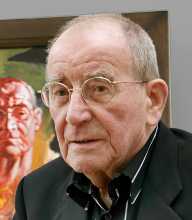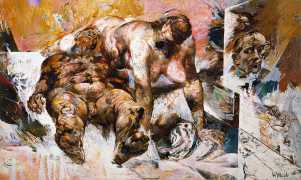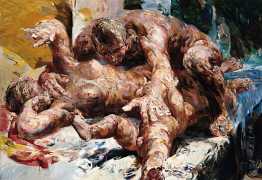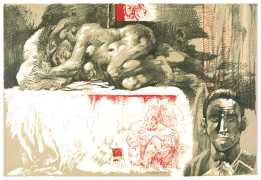 Willi Sitte grew up in Chrastava, in the northern part of the Czech Republic bordering Germany, which was then in the German-speaking part of Czechoslovakia and called Kratzau. His talent for drawing was encouraged early on by a drawing teacher, and after leaving school in 1936 he studied textile pattern design at the art school of the Nordböhmisches Handelsmuseum (North Bohemian Trade Museum) in Reichenberg (now Liberec). In 1940 he was recommended to the Hermann Göring Master School for Painting in Kronenburg in the Nordrhein-Westfalen. His criticism of the tasks there led to his conscription into the Wehrmacht on the Eastern Front in 1941. There he fell ill with jaundice and, after a home leave, was transferred to Italy, where in 1944 he deserted and joined the Italian partisans.
Willi Sitte grew up in Chrastava, in the northern part of the Czech Republic bordering Germany, which was then in the German-speaking part of Czechoslovakia and called Kratzau. His talent for drawing was encouraged early on by a drawing teacher, and after leaving school in 1936 he studied textile pattern design at the art school of the Nordböhmisches Handelsmuseum (North Bohemian Trade Museum) in Reichenberg (now Liberec). In 1940 he was recommended to the Hermann Göring Master School for Painting in Kronenburg in the Nordrhein-Westfalen. His criticism of the tasks there led to his conscription into the Wehrmacht on the Eastern Front in 1941. There he fell ill with jaundice and, after a home leave, was transferred to Italy, where in 1944 he deserted and joined the Italian partisans.
After working as an artist in Milan, Vicenza and Venice, Sitte returned to Kratzau in 1946, but was forced to leave his homeland due to the expulsion of Germans from Czechoslovakia, and then lived in Halle, north of Leipzig, where he joined the Sozialistische Einheitspartei Deutschlands (Socialist Unity Party of Germany) in 1947. In 1951 Sitte was given a teaching position at the Burg Giebichenstein Art Academy, and in 1959 was appointed professor. From 1965 to 1975 he was listed as a secret informant for the Stasi, the state security service, but was considered politically unreliable, and tended to use his position to subvert the system rather than support it, though facts are hard to come by for this shady activity. From 1986 to 1989 Sitte was a member of the Central Committee of the SED Central Committee.
The artist’s struggle with the party and the party with its painter culminated for the first time in 1961 in two suicide attempts, followed by party proceedings and finally in early 1963 with the self-criticism demanded by the party, which he made publicly in February 1963. In the summer of 1963 he was given his first solo exhibition in the Angermuseum in Erfurt.
Willi Sitte married Irmgard Kindler in 1947, and their son Volkmar was born in 1949. The marriage ended in 1963, and he then married the graphic artist Ingrid Dressler, with whom he had a daughter, Sarah, in 1966.
Sitte’s political involvement did not diminish his productivity as a painter and university professor. In 1969 he was elected a full member of the German Academy of Arts, a position he held until 1991, and is considered by many to have been the most important painter in the German Democratic Republic. He was committed to training young artists, including serving as director of the Fine and Applied Arts Department at the Academy of Industrial Design in Halle from 1975 to 1987.
Because of his commitment to communism and his party career in the SED, his works and exhibitions sparked public debate after reunification. In the summer of 2001 a planned anniversary exhibition of the artist’s eightieth birthday at the Germanisches Nationalmuseum in Nuremberg was postponed at short notice by the administrative council because they wanted to investigate his role as a GDR cultural functionary more closely. Sitte cancelled the exhibition that had already been prepared, and instead exhibited in Milan. On the occasion of his 85th birthday, the Willi Sitte Gallery was opened in Merseburg in 2006.
The Willi Sitte Gallery’s website can be found here.
We are very grateful to our Russian friend Yuri for suggesting the inclusion of this artist, and for supplying many of the images.





























































































